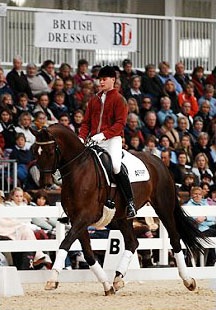
It was all about going back to basics, keeping it simple and using logic, however unconventional, to achieve the right results at the THB British Equestrian National Convention 2006, held at Addington Manor, Bucks, on 11-12 November.
The world’s top rider Anky van Grunsven told an audience of more than 1,100: “Don’t do something just because your teacher tells you to. You should understand why.”
Anky and her partner Sjef Janssen have caused turmoil in the dressage world with their independent thinking, disregard for the German system and use of a training tool known as Rollkur, hyperflexion or LDR (low, deep and round).
Spencer Wilton, who has enjoyed a meteoric rise to fame at grand prix level this year, was one of the five guinea pigs used to demonstrate Sjef and Anky’s training techniques.
He said: “Sjef and Anky have shaken the foundations of the sport. The fact is that Anky is one of only two riders to have won individual Olympic medals on more than one horse, so she must be doing something right.”
All the riders were encouraged to work their horses in a long frame with the head low during the warm-up in particular. Anky warned against doing this for too long, especially in the canter, as it is difficult for the horse to keep his balance. She feels it is important to be able to position the horse’s neck where you want to and to vary its position during training. She showed its effectiveness with the help of Roland Tong, who needed to relax Nadonna’s back to improve her working trot.
Anky and Sjef stressed the importance of warming up correctly without asking the horse to perform anything too demanding, such as lateral work.
Anky said: “It is good for riders to do other sports, to go to the gym for example, as you learn the importance of warming-up and cooling down properly and what it is like to have sore muscles. We train our horses hard for perhaps two or three days, but then they will have three or four days of less demanding work.”
In the same vein, Anky and Sjef made sure the riders gave their horses regular breaks during the training sessions.
“You should reward your horse by allowing him to stretch his head down and relax his muscles every five minutes or so, sometimes even every two minutes if he has done something difficult,” said Anky.
Keeping the horse’s mind happy is something Anky and Sjef carry through to their horses’ daily routines. Apart from being ridden, their horses are grazed in hand or lunged and also go on a horse walker, usually twice a day.
Anky made her first controversial point when she told Gareth Hughes not to use his legs in the downward transitions.
She said: “When I drive a car, I never use the accelerator to slow down.”
However, Anky made it clear that it only works if the horse is “thinking forward” and does not have to be pushed every step by the rider. Gareth was asked to ride many transitions, ½ and ¾, whereby he nearly went back to a walk from a trot and immediately rode forward again to make sure Duvie was responding instantly to a gentle leg aid.
Anky asked all the riders to work on transitions, particularly within paces, as she believes being able to control the horse’s speed is vital.
“If you have speed control, you have the horse’s concentration,” she said.
Anky encouraged the riders to use their voice to slow the horses down. She feels voice aids should be allowed in competition.
“If you use the voice, you probably don’t even need the reins. It is the nicest aid you can give,” she said.
It was therefore no surprise that Anky would not allow any of the riders to ride with a whip unless they had a good reason.
“I am not against using a whip, but I don’t believe you should ride with one out of habit,” said Anky, who applies the same rule to overreach boots.
The next controversial issue was raised when Sjef said: “Whoever invented the ‘inside leg to outside rein’ rule should be killed.” He did tone this down later, saying it was a tool that should be used only when needed.
Sjef raised this subject after pointing out that Simone Ward was riding the 10-year-old Oberon VI too deep into the corners, which was unbalancing the horse. Sjef noticed this was because Oberon was not straight.
With Andrew Gould, Sjef demonstrated a simple test to check your horse’s staightness. Ride a 20m-circle in trot or canter and drop all the aids, keeping the circle with the inside rein only if necessary. If the horse falls out or in, he is not straight. Sjef then used leg-yielding exercise to correct this.
Article courtesy: British Dressage
Photo copyrighted: Kevin Sparrow - No reproduction allowed
Related Links
Ferrer-Salat Takes THB British Dressage National Convention 2005
‘Curbed’ Discussions at the 2006 Global Dressage Forum